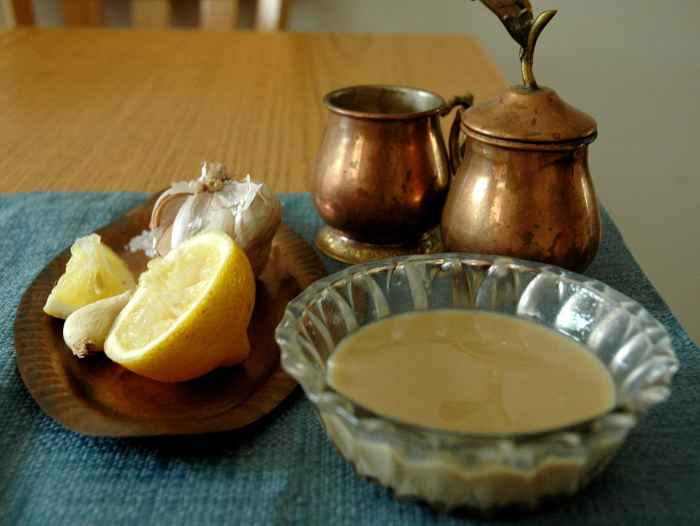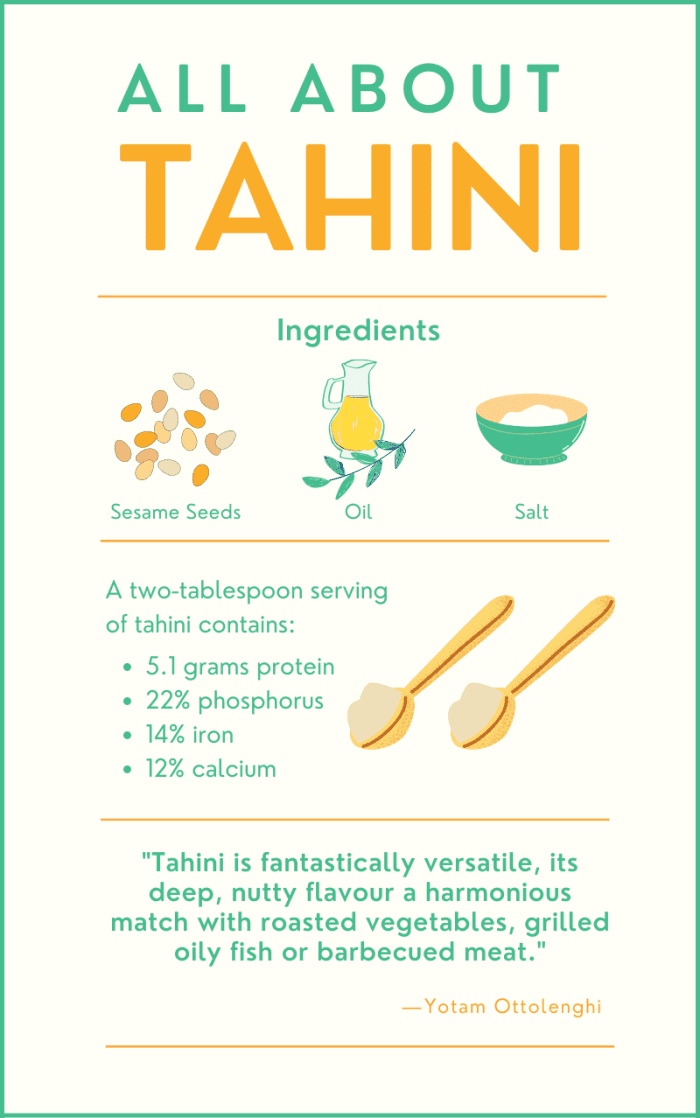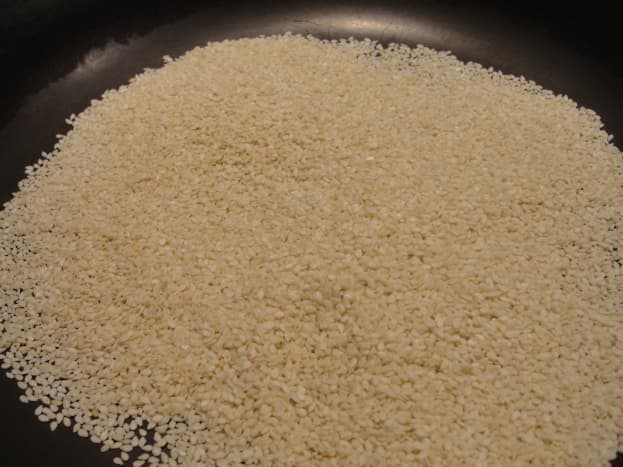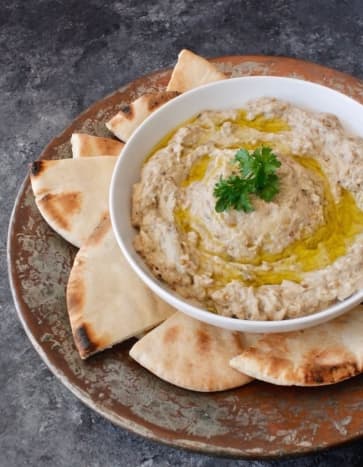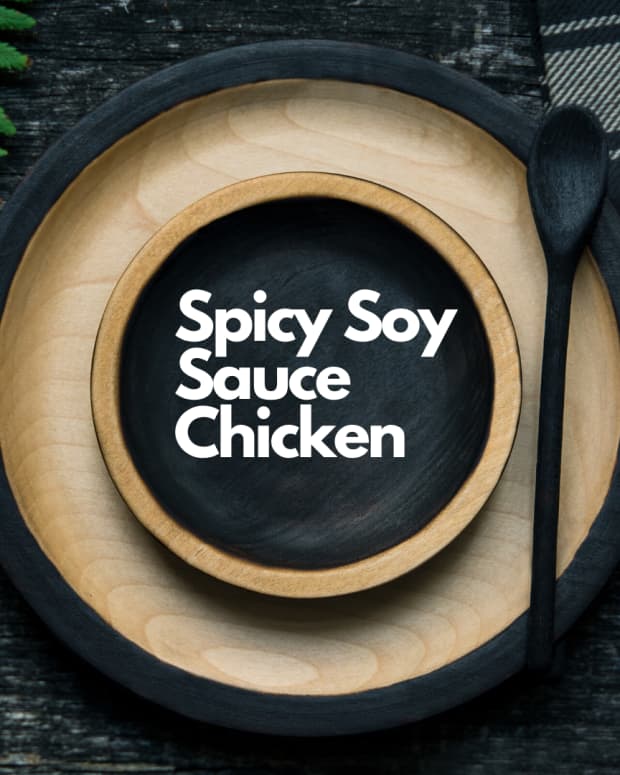What Is Tahini? History, Uses, and Six Easy Recipes
Linda explores food facts, folklore, and fabulous recipes, one ingredient at a time.
What Is Tahini?
Tahini is a paste made by pulverizing gently toasted hulled sesame seeds. It can be used as a dip for fresh vegetables, stirred into soup, drizzled on a salad, or even baked into cakes and cookies. You’ve probably tasted it in hummus and baba ghanoush. However, once upon a time, it was little more than a discard, a byproduct of sesame oil production.
Origins of Sesame and Tahini
More than 5,000 years ago the sesame plant was cultivated because of its drought-tolerance; it would flourish where other crops would wither and die. Indigenous to the Sundra Islands of Indonesia, it spread across thousands of miles and several continents (with the aid of nomads, adventurers, explorers, and conquerors). In China it was burned to make the soot for inkblots; Egyptians used it as fuel in their lamps. In India it had a much more somber use—Hindus use sesame oil in their funeral rituals.
Today the seeds are grown throughout Asia and East Africa and are put to use in numerous ways, but the condiment tahini is considered a Middle Eastern specialty.
How Does Sesame Grow?
Sesame, or Sesamum indicum, is a tall, slender annual with stems reaching up to six feet in height. Its fragrant white/lavender flowers mature to form capsules full of seeds. Ripening takes from three to four months, and then the plants drop their leaves. The warmth of the sun bakes the capsules, turning them a golden brown. The seeds burst forth, falling on the waiting clean cloths spread below. Winnowing sticks separate the seeds from the chaff.
How to Make Easy Homemade Tahini Sauce
The recipe for tahini is unbelievably simple—just sesame seeds, oil, and a pinch of salt. Many recipes online will recommend that you use a food processor, but in my experience, a blender is much more efficient, especially if you are using less than two cups of sesame seeds.
Ingredients
- 1 cup raw hulled sesame seeds
- 1/4 cup olive oil or canola oil
- About 1/4 teaspoon salt
Instructions
- Pour your raw, hulled sesame seeds into a shallow, dry saute pan (don't put any oil into the pan).
- Toast the seeds over medium-low heat, stirring constantly, until they begin to turn slightly golden and give off a toasty smell, probably 3 minutes or so. Watch them carefully. This isn’t the time to feed the dog, fold the laundry, or take a phone call. Sesame seeds can instantly go from charming to charred.
- Immediately pour the toasted seeds into the jar of your blender (yes, while they are still hot).
- Add the oil to the blender and begin to process the sesame seeds. At first, it will seem that nothing is happening (except for a lot of noise). But in about 2 minutes you should notice that the seeds in the middle of the jar (at the vortex) are beginning to liquify.
- Stop the blender and, using a scraper, push down the seeds on the sides of the jar. Continue to blend, scraping the sides occasionally, until the mixture is smooth and creamy. How long this takes depends on the speed of your blender. My batch of tahini was ready in 5 minutes.
- Pour your tahini into a clean jar that seals tightly and store it in the refrigerator. Your tahini should be good for two months. It might get a bit solid (firm) when chilled, but don’t worry. Just take it out of the refrigerator about 15 minutes before you plan to use it.
Tahini Sauce Photo Guide







Tahini FAQs
We've covered some of the history of sesame seeds and tahini—as well as a basic tahini sauce recipe—but you may still have questions. Don't worry, you've come to the right place!
What does it taste like?
When properly prepared, tahini has a sweet, mild, almond-like flavor. There is a subtle bitter end-note, but tahini enthusiasts appreciate this palate-cleansing quality and enjoy its depth and complexity.
Help, my tahini is bitter! How can I reduce the bitterness?
Some people complain that tahini can have a bitter aftertaste. A little is acceptable (see the note above about flavor), but if the tahini you are tasting makes your eyebrows arch, there might be a problem with how it was made. There are several things that could go wrong:
- Overcooked seeds: The problem might be from the toasting of the seeds; they are small and can quickly go from choice to charred in a matter of moments.
- Improper storage: Because tahini is high in fat (it’s an oil) it can easily go rancid. How you store it is important (see the next tip below).
How do you store tahini?
An unopened jar of tahini should be stored in a cool, dry place, away from sunlight. Once opened it should be refrigerated. Homemade tahini should always be stored in the refrigerator and should be good for about two months.
How can you tell if tahini has gone bad?
If you’re unsure about your tahini (is it too old?), your nose knows. Tahini that is going “bad” will have a rancid smell (off and kinda funky). Age isn’t really a consideration if you’ve stored it properly (see above).
How is it used?
Your first introduction to tahini might have been in a sampling of hummus or baba ghanoush (it flavors both of them). But that’s just the beginning. This savory sesame paste can be used as a dip on its own, as a salad dressing, and even appears (very stunningly, I might add) in chocolate recipes. I've shared my favorite recipes below.
Is tahini bad for you?
- Fat: Tahini is high in fat. This doesn't necessarily mean it's bad for you—a healthy diet requires the inclusion of some fats—but it means it should be consumed in moderation.
- Possible allergen: Sesame seeds are not tree nuts, but they do share some common proteins. People with tree nut allergies should consult with their allergist for specific advice.
According to the United States Department of Agriculture (USDA) National Nutrient Database, a two-tablespoon serving of tahini made from roasted sesame seeds and weighing 30 grams contains:
- 178 calories
- 16.13 grams of fat
- 6.36 grams of carbohydrates
- 2.8 grams of fiber
- 0.15 grams of sugar
- 5.1 grams of protein
What are the best tahini substitutes?
If you have a recipe that calls for tahini but you don't have any on hand, you can substitute one of these ingredients. They won’t have the same taste but will be in the ballpark.
- Almond butter
- Peanut butter
- Sesame oil
Tahini vs. sesame paste: What’s the difference?
Whereas tahini is made from lightly toasted sesame seeds, sesame paste (also known as sesame butter) is made from darkly toasted sesame seeds. The flavor of sesame paste is rich and robust, much like toasted sesame oil. It’s commonly used in Chinese cuisine.
What is the best store-bought tahini?
There are many different brands of tahini on the market and their availability will, of course, vary by region. When shopping for tahini look for a product that is made from organic sesame seeds. Some brands will contain salt; others are salt-free. There should be no other additives.
Hummus
Ingredients
- 1 cup dried chickpeas
- 2 teaspoons baking soda, divided
- 3 garlic cloves
- 6 tablespoons fresh lemon juice
- 1 teaspoon kosher salt
- 2/3 cup tahini (homemade is best)
- 1/4 cup extra-virgin olive oil for garnish
Instructions
- Place the chickpeas and 1 teaspoon of the baking soda into a large covered saucepan. Add enough water to bring the level of the water 2 inches above the chickpeas. Soak overnight, at least 12 hours. (If your kitchen is warm, store the chickpeas in the refrigerator.)
- The next day, rinse and drain the chickpeas. Return them to the saucepan and cover again with water 2 inches above the level of the chickpeas. Stir in the remaining 1 teaspoon of baking soda.
- Bring to a boil then reduce the heat to simmer. Cover and cook until the beans are soft and beginning to fall apart (about 60 minutes). As the beans cook skins will loosen and float to the surface; skim them off and discard.
- When the beans are tender (you want them almost falling apart), allow them to cool in their cooking liquid, stirring them from time to time to loosen the skins; strain off any that float to the top.
- While the chickpeas are cooling, blend the garlic with the lemon juice and salt in a food processor and let sit for 10 minutes.
- Add the tahini and continue blending until smooth, light, and fluffy. If the mixture seems too stiff, add 1 tablespoon of ice water.
- When the chickpeas are cooled, drain them, discarding the skins that separate from the peas, and add them to the food processor. Blend until completely smooth, 3 to 4 minutes. Taste for seasoning and add a little more salt or lemon juice as necessary.
- Serve with a generous drizzle of olive oil on top.
Note: Did you notice that I mention three times that you should remove the skins from the chickpeas? For the creamiest hummus, you will want to seek out those skins and whisk them away. However, if you are the type of person who enjoys hummus with a chunky texture you can ignore my pleadings.




More Recipes That Use Tahini
- Baba Ghanoush: Tori Avey’s website is the place I always go to when in search of a Middle Eastern dish. I can rely on her cooking to always be authentic and well researched.
- Creamy White Bean, Broccoli, and Tahini Soup: Despite the fact that this rich and flavorful soup is vegan, dairy-free, and gluten-free, it’s creamy, hearty, and nutritious.
- Classic Lemon Tahini Sauce: If you go online you can find countless recipes for tahini-based salad dressing, but I’ve selected for you a simple tangy lemon and tahini dressing that you can use in so many, many ways. I can imagine it flavoring a simple green salad, a side dish of cucumbers and garden-fresh ripe red tomatoes, or perhaps in lieu of a Caesar dressing with a green salad and rotisserie chicken for a light, refreshing summertime meal.
- Chocolate Fudge Tahini Cookies: If you like brownies, fudge, or anything dark chocolate, this is your cookie. They are sinfully rich, dark, and gooey. Even better—they are gluten-free. The flavor of tahini enhances that slightly bitter edge that dark chocolate enthusiasts know and love.
Sources
- Bernhardt, Ed. The History and Science of the Sesame Seed. Tico Times. Sept., 11, 2012.
- Sesame: Its Importance in Japanese Cuisine. Umami Insider. Mar. 10, 2020.
- Sesame Seed: The Facts and Flavors of One of the Most Versatile Crops. Pacific Spice. Feb. 21, 2020.
- Singer, Emma. Looking for a Substitute for Tahini? Here Are 6 Delicious Options. Pure Wow. May 25, 2020.
- Swaminathan, London. ‘Open Sesame’: Password to Heaven. Tamil and Vedas. Dec. 23, 2013.
- Ware, Megan. What Are the Health Benefits of Tahini? Medical News Today. Feb. 23, 2018.
© 2021 Linda Lum
Comments
Linda Lum (author) from Washington State, USA on March 16, 2021:
Adrienne, I did not know that. Thanks for that information. Yes, I hope you'll give tahini a try. It has a unique savory flavor.
Adrienne Farricelli on March 16, 2021:
This sounds like a cool ingredient to give a try. I was just reading the other day how sesame can turn helpful to those women in menopause or pre-menopause as it helps balance hormones.
Linda Lum (author) from Washington State, USA on March 16, 2021:
Thank you Devika. I hope you will have an opportunity to use some of my recipes.
Linda Lum (author) from Washington State, USA on March 16, 2021:
Thank you Doris. I love Middle East foods/flavors and am glad I was asked to write an article on tahini--it forced me into making my own. It's incredibly easy and so tasty.
Devika Primić from Dubrovnik, Croatia on March 16, 2021:
I like the recipes and unique flavors.
Doris James MizBejabbers from Beautiful South on March 15, 2021:
You certainly drew me in this week, Linda. I like to make my own hummus, but I use store-bought tahini and canned chickpeas (garbanzo beans). Even taking the lazy out comes up with a good product. I love the lemon hummus, and I usually don't go for lemon-flavored food. I had no idea I could make my own tahini. Will I try making my own? Perhaps in the future, but right now I'm too busy. Good article, my friend.
Misbah Sheikh from The World of Poets on March 15, 2021:
Sure, Linda, I will share my thoughts and experience with you
So kind of you dear
Blessings
Linda Lum (author) from Washington State, USA on March 15, 2021:
Misbah, I am so very happy to receive a message from you. Thank you for taking the time to leave a comment. If you make the tahini from my recipe, I hope you will let me know your thoughts.
Misbah Sheikh from The World of Poets on March 15, 2021:
Linda, I like Tahini sauce, but I have never tried it making at home
I will definitely give it a try
you explained very well from the sesame seeds to tahini sauce on the table,
The tips and tricks are also helpful
Thanks a lot for sharing this wonderful article with delicious recipes
Blessings
Linda Lum (author) from Washington State, USA on March 15, 2021:
Gimmesomeoven is one of my (many) favorite foodie websites. She does GOOD stuff. As for Goodwill, I haven't even been in a grocery store in a year.
Shauna L Bowling from Central Florida on March 15, 2021:
That's good to know, Sis. I kinda thought I'd have to buy the sesame seeds online. Not a problem.
Goodwill. Holy mackerel, I used to go there all the time. Haven't done any thrift store shopping in quite a while. Sounds like a Saturday jaunt to me!
I found the hummus-crusted chicken recipe on gimmesomeoven.com. It's roasted with yellow squash, zucchini, and onion. Absolutely delicious! Even my son liked it and he's not a hummus eater.
Linda Lum (author) from Washington State, USA on March 15, 2021:
Shauna, I bought my sesame seeds thru Amazon; a 9- ounce jar for about $6.00. As for the hummus, yes, you can certainly use canned chickpeas. Since I work at home, I have the luxury of time so always cook my own beans.
By the way, your chicken recipe sounds wonderful, not weird at all.
Speaking of roasted garlic, I have one of those teeny tiny slow cookers meant for keeping sauces warm (not to be used for cooking). I placed whole garlic cloves (a whole head) in it and covered with olive oil. After two hours they were golden and as soft as butter. I bought mine at Goodwill for a dollar.
Shauna L Bowling from Central Florida on March 15, 2021:
Yum! I had no idea making tahini is so easy. Where do you buy hulled sesame seeds, Linda? Can I get them at the grocery store? I've only seen sesame seeds sold in small jars in the spice isle.
I love hummus. I always have a family size tub of Sabra hummus in my fridge. I use it as a dip for veggies and a sandwich spread in lieu of mayo. I recently came across a recipe for hummus crusted baked boneless, skinless chicken breasts. It may sound weird, but it was delicious!
I would love to try my hand at making hummus from scratch. Is it possible to use canned chickpeas? There are so many yummy ingredients you can add to basic hummus, such as roasted pine nuts, roasted garlic (my favorite), sundried tomatoes, etc.
Bill's comment surprised me, too. I thought for sure, he'd poo poo this one!
Linda Lum (author) from Washington State, USA on March 15, 2021:
Hi Pamela, I knew you'd be here soon; your kind comments always cheer me up. Do treat yourself to some tahini or hummus. If you grow tired of it as a dip, you could use it as a sandwich spread. Goes great with chicken or turkey.
Pamela Oglesby from Sunny Florida on March 15, 2021:
I may have had tahini in hummus, but I have never made it eaten t as far as I know. I have heard of it but you certainly educated me, Linda.
I love all of the recipes you shared, I know I would probably like all of them, as they sure sound good. At the very least I am going to at least buy some hummus soon, as that is something I like. Thanks for giving us all of this information,
Linda Lum (author) from Washington State, USA on March 15, 2021:
Bill, I'm shocked! Seriously, I was certain you would give this a big thumbs down. You've started my week with a smile
Linda Lum (author) from Washington State, USA on March 15, 2021:
Manatita, my dear Mother cooked perhaps a dozen dishes; there was no adventure in her cooking. Just no nonsense no frills food to fill the stomach. I knew there had to be more, so I've spent years reading and learning. It's so much fun.
Bill Holland from Olympia, WA on March 15, 2021:
I've heard of it, but had no clue what it was until this moment, so I thank you for filling in a gap in my education. Now, would I eat it? Probably. It seems fairly harmless. lol
Have a great week, my friend!
manatita44 from london on March 15, 2021:
Linda,
You strike me as a woman who stays indoors. So how do you know of these exotic dishes? Perhaps you're dying to get out like me; to travel once more. Ha-ha.
I never knew that Tahini came from sesame seeds. I use to eat it a lot in Leicester Square, near Piccadilly. There are many Greek and middle-eastern restaurants there. I use it with pitta bread and falafels. Awesome taste!
Ann Carr from SW England on March 15, 2021:
Ah aubergine. Why didn't I think of that! Love that too! Thanjs, Linda.
Ann
Linda Lum (author) from Washington State, USA on March 15, 2021:
Good morning Ann. Baba ghanoush is eggplant (I think you call them aborgine?) for those who don't like eggplant. It's a Middle East dip with an intruiging smokey taste. Now I'm hungry too.
Thank you for your kind words.
Ann Carr from SW England on March 15, 2021:
This is great, Linda! I love sesame and I love chick peas. I also love your phrase, 'from charming to charred'! That's a good, memorable warning.
As always, all the history goes with this - I think that when cooking it makes its preparation and eating all the better knowing its background.
I have no idea what Baba Ghanoush is but it looks good! l have tasted hummus though.
Now I'm hungry and it's not long since breakfast! Off to have a cup of coffee.
I enjoyed this cookery/history lesson, Linda. Thanks.
Ann
Linda Lum (author) from Washington State, USA on March 14, 2021:
Peggy, if you have a blender, you can do this!
Peggy Woods from Houston, Texas on March 14, 2021:
We have never made homemade tahini. But we buy it and use it in different recipes. We love hummus and Baba Ghanoush!
Linda Lum (author) from Washington State, USA on March 14, 2021:
Oh Flourish, I think you'll like it. (I can hardly wait to see Bill's remarks).
FlourishAnyway from USA on March 14, 2021:
I’m one of those inexperienced people who have never tried hummus. It’s ingredients have always made me suspect but I’d spread homemade tahini on a cracker to try it’s an adventure.

